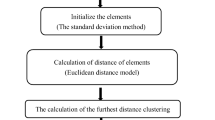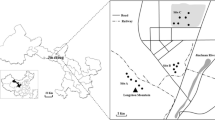Abstract
Rainwater heavy metal contamination is a growing problem worldwide, which damages the environment and human health. A primary challenge of sponge city designers is selecting suitable plants capable of surviving the toxic metals present in city rainwater. The concept of a sponge city to tackle urban surface-rainwater flooding and related urban rainwater management issues was established by People’s Republic of China in 2014. Therefore, we studied the ability of sponge city plants to accumulate heavy metals from rainwater. Ophiopogon japonicus (Linn. f.) Ker-Gawl., Carex heterostachya Bge., Cornus officinalis Sieb. et Zucc., Sedum spectabile Boreau., Typha orientalis Presl., Lythrum salicaria L., Fatsia japonica (Thunb.) Decne. et Planch., Ilex chinensis Sims., Rosa chinensis Jacq., and Buxus bodinieri Levl. were selected as test plants, and their ability to accumulate four heavy metals (lead [Pb], cadmium [Cd], copper [Cu], and zinc [Zn]) was compared. Growth response and heavy metal accumulation across different species were compared over a 28-day enrichment cycle. The results showed that (1) Plant growth responses to heavy metals were significantly different. The most tolerant to heavy metals was Lythrum salicaria and the least tolerant was Rosa chinensis. (2) Concentrations of the heavy metals differed among sponge city plant species. In general, the concentration of Zn was highest, followed by Cu, Cd, and Pb. (3) The accumulation content of the same metal in different test species was related to the bioconcentration factor of the metal and the plant biomass. At the end of the enrichment cycle, Ophiopogon japonicus had the largest accumulation content for Pb, Cu, and Zn, and Lythrum salicaria had the highest accumulation content for Cd. (4) Considering the growth responses of plants and their final accumulation of heavy metals after the enrichment cycle, we concluded that Lythrum salicaria, Typha orientalis, and Ophiopogon japonicus are suitable for use in sponge cities to restore heavy metal-contaminated rainwater.











Similar content being viewed by others
References
Baker AJM, Brooks RR (1989) Terrestrial higher plants which hyperaccumulate metallic elements. A review of their distribution, ecology and phytochemistry. Biorecovery 1:81–126
Bermudez GMA, Jasan R, Pla R, Pignata ML (2011) Heavy metal and trace element concentrations in wheat grains: assessment of potential non-carcinogenic health hazard through their consumption. J Hazard Mater 193:264–271
Bhargava A, Carmona FF, Bhargava M, Srivastava S (2012) Approaches for enhanced phytoextraction of heavy metals. J Environ Manag 105:103–120
Bradshaw A (1997) Restoration of mined lands-using natural processes. Ecol Eng 8:255–269
Brooks RR, Lee J, Reeves RD, Jaffre T (1977) Detection of nickeliferous rocks by analysis of herbarium specimens of indicator plants. J Geoche Explor 7:49–57
Brown SL, Chaney RL, Angle JS, Baker AJM (1995) Zn and Cd uptake by hyperaccumulator Thlaspi caerulescens and metal tolerant Silene vulgaris, grown on sludge-amended soils. Environ Sci Technol 29:1581–1585
Capuana M (2011) Heavy metals and woody plants-biotechnologies for phytoremediation. iForest 4:7–15
Chan FKS, Griffiths JA, Higgitt D, Xu SY, Zhu FF, Tang YT, Xu YY, Thorne CR (2018) “Sponge City” in China—a breakthrough of planning and flood risk management in the urban context. Land Use Policy 76:772–778
Chandrasekhar C, Ray JG (2019) Lead accumulation, growth responses and biochemical changes of three plant species exposed to soil amended with different concentrations of lead nitrate. Ecotox Envir on Safe 171:26–36
Chen L, Zhou SL, Shi YX, Wang CH, Li BJ, Li Y, Wu SH (2018) Heavy metals in food crops, soil, and water in the Lihe River Watershed of the Taihu Region and their potential health risks when ingested. Sci Total Environ 615:141–149
Clemens S, Palmgren MG, Krämer U (2002) A long way ahead: understanding and engineering plant metal accumulation. Trends Plant Sci 7:309–315
Doty SL (2008) Enhancing phytoremediation through the use of transgenics and endophytes. New Phytol 179:318–333
Feng P, Sun L, Shen XH, Jiang C, Li RM, Li QJ, Zheng HY, Zhang H, Guo W et al (2016) Response and enrichment ability of perennial ryegrass under lead and cadmium stresses. Acta Pratacult Sin 25(1):153–162 (in Chinese)
Gall JE, Boyd RS, Rajakaruna N (2015) Transfer of heavy metals through terrestrial food webs: a review. Environ Monit Assess 187:201
Gleba D, Borisjuk NV, Borisjuk LG, Kneer R, Poulev A, Skarzhinskaya M, Dushenkov S, Logendra S, Gleba YY, Raskin I (1999) Use of plant roots for phytoremediation and molecular farming. Proc Natl Acad Sci U S A 96:5973–5977
Gong XM, Huang DL, Liu YG, Zeng GM, Wang RZ, Wei JJ, Huang C, Xu P, Wang J, Zhang C (2018) Pyrolysis and reutilization of plant residues after phytoremediation of heavy metals contaminated sediments: for heavy metals stabilization and dye adsorption. Bioresource Tech 253:64–71
Gratao PL, Prasad MNV, Cardoso PF, Lea PJ, Azevedo RA (2005) Phytoremediation: green technology for the cleanup of toxic metals in the environment. Braz J Plant Physiol 17:53–64
Kamnev AA, van der Lelie D (2000) Chemical and biological parameters as tools to evaluate and improve heavy metal phytoremediation. Biosci Rep 20:239–258
Li HE, Liu ZC, Qin YM, Du GF, Dong W (2012) Characteristics of snowmelt runoff pollution and comparison with rainfall runoff pollution in Xi’an City. Acta Scientiae Circumstantia 32(11):2795–2802 (in Chinese)
Li SN, Kong LW, Lu ZW, Chen B, Gao C, Shi Y (2013) Beijing common green tree leaves’ accumulation capacity for heavy metals. Environ Sci 35(5):1891–1900 (in Chinese)
Li Q, Wang F, Yu Y, Huang ZC, Guan YT (2019) Comprehensive performance evaluation of LID practices for the sponge city construction: a case study in Guangxi, China. J Environ Manag 231:10–20
Liu XH, Gao YT, Khan S, Duan G, Chen AK, Ling L, Zhao L, Liu ZH, Wu XC (2008a) Accumulation of Pb, Cu, and Zn in native plants growing on contaminated sites and their potential accumulation capacity in Heqing, Yunnan. J Environ Sci (China) 20:1469–1474
Liu JN, Zhou QX, Sun T, Ma LQ, Wang S (2008b) Growth responses of three ornamental plants to Cd and Cd-Pb stress and their metal accumulation characteristics. J Hazard Mater 151(1):261–267
Loreti E, van Veen H, Perata P (2016) Plant responses to flooding stress. Curr Opin Plant Biol 33:64–71
Maric M, Antonijevic M, Alagic S (2013) The investigation of the possibility for using some wild and cultivated plants as hyperaccumulators of heavy metals from contaminated soil. Environ Sci Pollut Res 20(2):1181–1188
McGrath SP, Zhao FJ (2003) Phytoextraction of metals and metalloids from contaminated soils. Curr Opin Biotechnol 14:277–282
Muhammad TA, Muhammad N, Abdul S, Tanveer M, Muhammad A (2018) Augmentation with potential endophytes enhances phytostabilization of Cr in contaminated soil. Environ Sci Pollut Res 25:7021–7032
Petoumenou MI, Pizzo F, Cester J, Fernández A, Benfenati E (2015) Comparison between bioconcentration factor (BCF) data provided by industry to the European Chemicals Agency (ECHA) and data derived from QSAR models. Environ Res 142:529–534
Rajkumar M, Prasad MNV, Freitas H, Ae N (2009) Biotechnological applications of serpentine bacteria for phytoremediation of heavy metals. Crit Rev Biotechnol 29:120–130
Reeves RD, Baker AJM (2000) Metal accumulating plants. In: Raskin I, Ensley BD (eds) Phytoremediation of toxic metals: using plants to clean up the environment. Wiley, New York, pp 193–229
Römheld V (1995) Diagnosis of deficiency and toxicity of nutrients. In: Marschner P (ed) Mineral nutrition of higher plants, 2nd edn. Academic Press, London, UK, pp 299–312
Salazar MJ, Pignata ML (2014) Lead accumulation in plants grown in polluted soils. Screening of native species for phytoremediation. J Geochem Explor 137:29–36
Sas-Nowosielska A, Kucharski R, Pogrzeba M, KrzyZak J, Kuperberg JM, Japenga J (2008) Phytoremediation technologies used to reduce environmental threat posed by metal contaminated soils: theory and reality. In: Barnes I, Kharytonov MM (eds) Simulation and assessment of chemical processes in a multiphase environment. Springer, New York, pp 285–297
Shah K, Nongkynrih JM (2007) Metal hyperaccumulation and bioremediation. Biol Plant 51:618–634
Shen ZJ, Wang YP, Chen YS, Zhang Z (2017) Transfer of heavy metals from the polluted rhizosphere soil to Celosia argentea L. in copper mine tailings. Hortic Environ Biotechnol 58(1):93–100
Wang QH, Que XE (2012) Phytoremediation—a green approach to environmental clean-up. Chinese J Eco-Agricul 21(2):261–266 (in Chinese)
Wang BS, Huang YL, Nie XB, Chai BB (2010) Studay on rainwater pollutant wash off in impervious surface. Chinese J Environ Engineer 40(9):1950–1954 (in Chinese)
Wei M, Liu X, Chen CQ, Yu XP, Peng XL (2008) The concentration of heavy metals in soil and dominant plants growing on spoiled heap from steel refinery. Acta Ecol Sin 28(6):2931–2936
Wu Y, Mu LQ (2008) Effect of soil Pb, Cd stress on the growth, physiological and accumulation characteristics of four ornamental trees. J Trop Crops 29(5):567–571
Yan L, Li BS, Ni XL, Li CX, Li J (2016) Accumulation of soil heavy metals in five species of wetland plants. Acta Botan Boreali-Occiden Sin 36(10):2078–2085 (in Chinese)
Zhang FJ, Lombi E, MeGrath SP (2003) Assessing the potential for zinc and cadmium phytoremediation with the hyperaccumulatorThlaspi caerulescens. Plant Soil 249(1):37–43
Zhang CM, Zhang CF, Zhu QQ, Jia YX, Luo X, Zhang SR, Li Y, Li T (2016) Physiological response and subcellular distribution of copper in Lantana camara L. J Agro-Environ Sci 35(01):21–28
Zhang X, Li M, Yang H, Li X, Cui Z (2018) Physiological responses of Suaeda glauca and Arabidopsis thaliana in phytoremediation of heavy metals. J Environ Manag 223:132–139
Zhang SH, Li YK, Ma MH, Song T, Song RN (2018a) Storm water management and flood control in Sponge City construction of Beijing. Water 10(8):1040
Zheng X, Zang WC, Yan ZG, Hong YG, Liu ZT, Yi XL, Wang XN, Liu TT, Zhou LM (2015) Species sensitivity analysis of heavy metals to freshwater organisms. Ecotoxicology 24:1621–1631
Zhong C, Ge XM, Ni Y, Tang LZ (2017) Research progress of phytore – mediation technology and resistance mechanism of Plant in Soil Polluted by Cd or Pb. World Forestry Research 30(1):37–43
Funding
This study was financed by the “Study on Application Technology of Soil Filling Medium in Sponge City Green Space in Xixian New Area (2017ZDXM-SF-083).”
Author information
Authors and Affiliations
Corresponding author
Additional information
Responsible editor: Elena Maestri
Publisher’s note
Springer Nature remains neutral with regard to jurisdictional claims in published maps and institutional affiliations.
Rights and permissions
About this article
Cite this article
Ma, W., Zhao, B. & Ma, J. Comparison of heavy metal accumulation ability in rainwater by 10 sponge city plant species. Environ Sci Pollut Res 26, 26733–26747 (2019). https://doi.org/10.1007/s11356-019-05827-2
Received:
Accepted:
Published:
Issue Date:
DOI: https://doi.org/10.1007/s11356-019-05827-2




